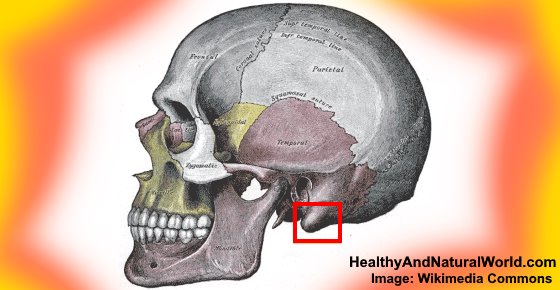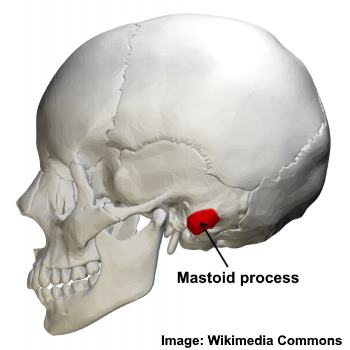Mastoid Process: Location, Function and Pain

Your mastoid process is a part of your temporal bone that is located just behind your ears. The mastoid process is a small triangular-shaped bone that protrudes from either side at the base of your skull. You can locate your mastoid if you place your fingers behind your earlobe. The main function of the mastoid process is to connect your neck muscles to your skull and help regulate pressure in your ear.
The mastoid process has a structure of a honeycomb full of mastoid air cells. The mastoid can become painful if you have a middle ear infection. This can happen because of inflammation due to infections, pus filling the mastoid air cells, trauma to the skull, or cysts just behind either of your ears. Usually, getting rid of pain in the mastoid process requires treating the underlying cause of pain behind your ears.
In this article, you will find out about the different reasons behind ear pain that is connected with your mastoid process. You will also find out how to treat middle ear infections to help prevent the mastoid process pain getting worse.
Location of the Mastoid Process
Your skull is made up of many bones that help to protect your brain. According to the Encyclopaedia Britannica, the mastoid process is located on either side of the head behind the ear. You will be able to locate the mastoid process easily by feeling for the protruding bone behind your ear.1
Many medical websites describe the mastoid process as a conical or pyramidal projection at the base of either side of your skull. That is why many doctors feel behind both ears to check for signs of pain or inflammation if you have a suspected ear infection.
The mastoid surrounds the inner and middle ear.
Function of the Mastoid Process
Although your mastoid process can become sore and inflamed if you have an ear infection or cyst behind your ear, its functions aren’t all connected with your hearing.
Many muscles and nerves in your head are connected to the mastoid process. These muscles connect to the mastoid process and help in rotating and flexing your head and also opening your jaw.
Also, according to information published by the Aalborg University, the mastoid process is involved in the swallowing process.2
Dr. Sabrina Felson on WebMD says that it is also thought that the air cells in the mastoid process help to regulate ear pressure and protect the delicate structures of the ear. Dr. Felson says that many vital structures pass through the mastoid.3
Symptoms of Mastoid Process Pain
If the area around the mastoid process becomes infected or inflamed, you will usually have pain behind your ear. It is possible that inflammation and swelling can occur in the honeycomb-type structure of the mastoid process.
According to Stanford Children’s Health, some of the common symptoms associated with mastoid pain are swelling behind the ear, fever, and drainage from the ear. In some cases, pain and inflammation in the mastoid process can cause temporary hearing loss.4
Professor of Otolaryngology Dr. Arlen Meyers says that pain behind the ear may be worse at night. To confirm the seriousness of ear infection causing the pain, doctors will take blood tests to check for high levels of white blood cells. There could also be signs of bacteria in swabs taken from the ear.5
Causes of Mastoid Process Pain
Let’s look in more detail why you might have pain and swelling behind one or both of your ears.
Middle ear infection causes mastoiditis
An infection in your middle ear (otitis media) is usually to blame for mastoid process pain and is commonly called mastoiditis.
According to Dr. Richard Miyamoto from the Department of Otolaryngology at the Indiana University School of Medicine, mastoiditis is a bacterial infection of the middle ear. The infection can cause pus to develop in the mastoid process bone and cause it to feel tender to touch and look visibly red and swollen. The mastoid process pain caused by a middle ear infection will feel like a throbbing persistent pain that is very uncomfortable.6
It is very important to seek medical attention for a middle ear infection that causes pain and swelling behind your ear. Dr. Sabrina Felson on WebMD says that complications from mastoiditis can be nausea and vomiting, dizziness, loss of hearing, severe headaches, and meningitis – which can be life-threatening.3
Doctors usually treat serious middle ear infections with antibiotics. These help to kill off bacteria that are causing a buildup of pus and stop discharge from your ear. Sometimes, surgery is needed to drain fluid from the middle ear or remove the infected mastoid.
If you have to take a course of antibiotics, it’s important to remember to take probiotics to help restore healthy bacteria to your gut. That can also help to prevent outbreaks of yeast infections as a result of antibiotics.
For information on how to treat mild cases of an outer ear infection, please read my article on how to get rid of an ear infection.
Cholesteatoma and pain in the mastoid process
One reason for mastoid process pain in just one ear is a cholesteatoma.
A cholesteatoma is a white mass of keratin that can form in the mastoid process. According to researchers from Harvard Medical School, cholesteatomas can form if there is a persistent hole in the eardrum or if the Eustachian tube is blocked. In time, the cholesteatoma can result in hearing loss and put a person at a greater risk of an inner ear infection.7
If the cholesteatoma causes mastoid pain with an infection, then symptoms of mastoiditis will be present. This includes smelly drainage from the ear, redness and swelling at the back of the ear, and mastoid process tenderness.
Usually, doctors have to remove the cholesteatoma to prevent repeated ear infections and permanent injury to the hearing.
Trauma to the side of your skull
Trauma to the temporal bone on the side of your skull where the mastoid process is located can cause pain and other complications.
There are a number of reasons why an injury to the area behind your ear can cause complications. The journal Craniomaxillofacial Trauma & Reconstruction reports that a blunt traumatic head injury can damage the mastoid process and cause pain. For example, there are nerves and muscles connected to your mastoid. Damage to the mastoid can cause facial paralysis, damage to the inner or middle ear, or internal bleeding.8
Doctors say that proper diagnosis of the extent of head injuries is essential to help get the best recovery. Dr. John Atkinson from the Mayo Clinic advises that there are some situations where you should visit your doctor for a head injury. Warning signs of complications from a head injury include dizziness, nausea and vomiting, blurred or double vision, confusion, or mood changes.9
Your doctor may order blood test for checking the levels of the enzyme creatine phosphokinase (or, CPK) in the blood. If you have any kind of head injury or damage to your brain tissue, it will cause CPK lab tests to show higher than normal results.
Mumps causing mastoid process pain
Mumps is a viral infection affecting mostly children that can cause mastoid process pain behind the ears and a swollen jaw.
The Centers for Disease Control and Prevention says that mumps is a contagious viral infection. It usually causes a fever and muscle aches, as well as swelling of the salivary glands.10 The University of Chicago says that the swelling can reach the mastoid process. This will cause the ear to be pushed out and upwards.11
Usually, the symptoms of mumps are treated by drinking plenty of fluids and resting in bed. Because mumps is contagious, patients are usually isolated from others to prevent spreading the infection.
Tumor in the mastoid process
In very rare cases, a cancerous tumor could be a reason for pain in the mastoid process.
The Ghana Medical Journal reported that sometimes squamous cell carcinoma can affect the mastoid. This causes headaches, fever, neck stiffness, and other signs of mastoiditis. Treatment requires surgery and radiotherapy.12
It is good to remember that in the majority of cases, swelling and pain behind one or both ears is usually the result of a middle ear infection and not cancer. Although this type of infection can be serious, it is usually treatable without any long-term complications.
When to See a Doctor for Mastoid Process Pain
Mastoid process pain that has signs of inflammation behind either ear should not be ignored. Inner or middle ear infections can cause serious complications and be difficult to treat if left too long. Also, children are more prone to mastoiditis and require prompt medical attention to treat signs of an ear infection.
According to doctors from the Mayo Clinic and WebMD, you should seek medical attention for suspected ear infections in the following circumstances:13, 14
- Mastoid pain behind the ears lasts for more than one day.
- The pain is very severe and is persistent.
- You notice discharge or pus draining from your ear.
- A child who is less than 6 months old has ear infection symptoms.
- Along with pain and swelling behind the ear, you have hearing loss, dizziness, or nausea.
- You or your child has a stiff neck and high fever.
Read my other related articles:
- The Best Home Remedies For Getting Rid of Ear Infection
- How to Naturally Get Rid of Clogged Ears
- This Will Make You Stop Cleaning Inside Your Ears
- Otitis Interna: Causes, Symptoms and Treatments
Article Sources

